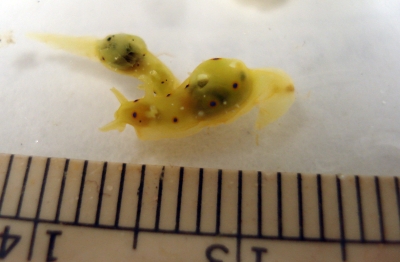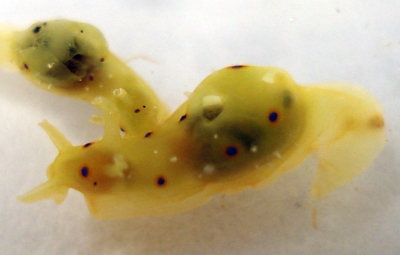Sea hares on floating pumice
December 30, 2006
From: Kathe R. Jensen

Dear Bill,
I realize that this message will not get on the forum till after New Years. However, we are getting off the Galathea 3 ship tomorrow morning, and I am not sure what internet connections will be like in Gizo, Solomon Islands.
A couple of days ago, while we were hauling in long-lines, we noticed patches of brown material floating on the surface. At first we thought it was Sargassum weed or something like that. So we sent out a zodiac to pick up some, and it turned out to be floating pumice rubble, most of which was covered in gooseneck barnacles. I set out looking for Fiona, but to my surprise found little yellow sea hares, which turned out to be Stylocheilus longicauda (or citrina?). Most of them were about 10-20 mm long, and I collected at least 20 specimens from a 10 liter bucket.
Locality: Coral Sea, surface, South Pacific, 22 December 2006, from floating pumice. Length: about 10-15 mm. Photographer: Kathe Jensen.
Happy New Year to everyone,
Kathe
krjensen@snm.ku.dk
Jensen, K.R., 2006 (Dec 30) Sea hares on floating pumice. [Message in] Sea Slug Forum. Australian Museum, Sydney. Available from http://www.seaslugforum.net/find/19091
Dear Kathe,
I wasn't planning to post any more messages until the New Year but your interesting message and New Year's have made me change my mind.
This is indeed Stylocheilus longicauda. As I explained when sorting out the name of this animal [see S. longicauda & S. citrina - nomenclatural discussion] Rang's S. citrina from the Atlantic is identical to Quoy & Gaimard's S. longicauda from 'off New Guinea'. To add to the confusion, the name Stylocheilus longicauda was for many years applied to the benthic species Stylocheilus striatus. As your specimens show, S. longicauda is usually found in the open sea attached to floating brown algae, or in your case volcanic pumice. The name longicauda [= longtail] is very appropriate, as it refers to an adaptation this species has evolved to remain attached to its floating 'home' - the posterior end of the foot can extend into a long ribbon-like 'tail' which exudes a very sticky mucus.
Good Luck with the rest of your expedition
Best wishes,
Bill Rudman
Related messages
-
Re: Stylocheilus longicauda and eggs [2]
From: Denis Riek, November 19, 2009 -
Re: Stylocheilus longicauda and eggs [1]
From: Denis Riek, November 19, 2009 -
Re: The real Stylocheilus longicauda from eastern Atlantic
From: Denis Riek, August 26, 2009 -
The real Stylocheilus longicauda from eastern Atlantic
From: Peter Wirtz, August 20, 2009 -
The real Stylocheilus longicauda from Rarotonga
From: Graham McDonald, May 24, 2006 -
Stylocheilus longicauda and eggs(?)
From: Mike Greenemeier, June 16, 2005 -
Stylocheilus longicauda from India
From: Barbara Gibson , October 3, 2002 -
Stylocheilus longicauda from Hawaii
From: Erwin Koehler, August 10, 1999 -
True Stylocheilus longicauda from Caribbean
From: Betsey Hansen, August 6, 1999
